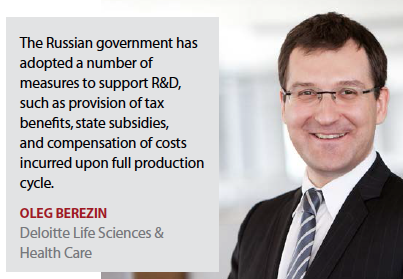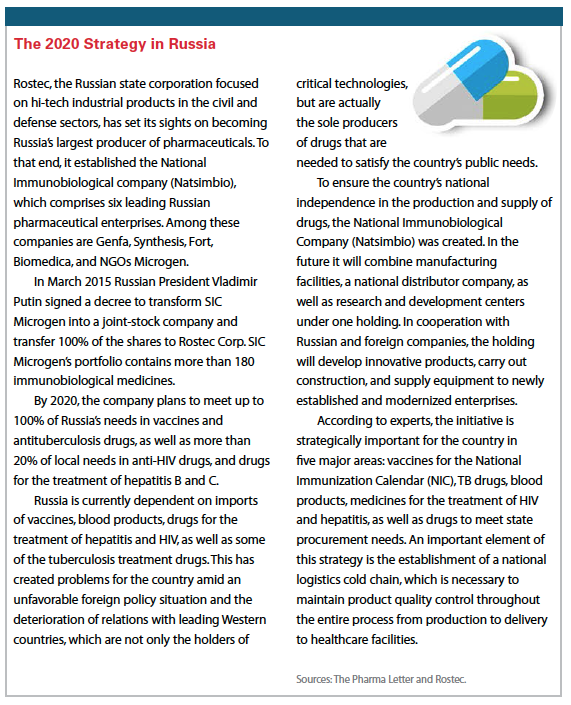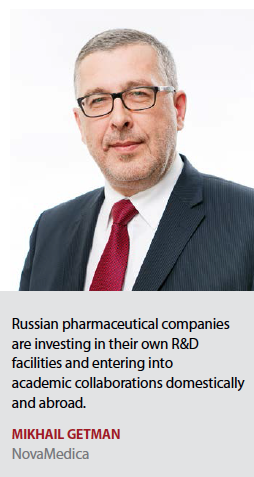The world’s largest nation, Russia remains an attractive market for most industries. Nevertheless, the country has struggled through a rough economic period, rocked by a drop in the value of the currency and turbulence in the oil market. Geopolitical pressures have raised challenges, including sanctions imposed on the country.
 In the pharmaceutical industry, despite the current state of the Russian economy and market challenges, such as flaws in industry regulations and insufficient governmental funding in certain areas, there is general optimism about growth prospects, says Oleg Berezin, Deloitte Life Sciences & Health Care lead in Russia.
In the pharmaceutical industry, despite the current state of the Russian economy and market challenges, such as flaws in industry regulations and insufficient governmental funding in certain areas, there is general optimism about growth prospects, says Oleg Berezin, Deloitte Life Sciences & Health Care lead in Russia.
This optimism is underscored in several ways, including the construction of manufacturing facilities in Russia and the establishment of alliances between foreign and Russian companies, Mr. Berezin says.
Focus on Localization
Until 2014, the Russian pharmaceutical market had one of the best compound annual growth rates globally — more than 10% — which was a significant draw for international and domestic investors in both R&D infrastructure and production, says Mikhail Getman, VP of pharmaceutical operations at NovaMedica.
“Political pressure from the European Union and United States exposed the Russian economy and brought significant influence on the Russian exchange rate, which fell 80% to 90% in 2015," Mr. Getman says. In dollar terms, this caused a drop in sales.
The current pharmaceutical market situation does, however, provide some sound upside to the domestic industry, which significantly increased its market share over international companies due to price competition and some new regulations supporting pharmaceutical production localization, Mr. Getman adds.
Russia has been heavily dependent on imported drugs and APIs, and currently up to 75% of all drugs on the Russian market in monetary terms are imported, Mr. Berezin says.
 To mitigate the situation, the Russian government adopted a Pharma 2020 program with the aim to decrease the ratio of imported drugs by 2020 to 50%, and for essential drugs to 10% of the total number of items.
To mitigate the situation, the Russian government adopted a Pharma 2020 program with the aim to decrease the ratio of imported drugs by 2020 to 50%, and for essential drugs to 10% of the total number of items.
In November 2015, the government issued a resolution limiting procurement for state and municipal needs of foreign medicines included on the list of the most important and essential drugs, known as the EDL list. The resolution goes into effect Jan. 1, 2017, and is designed to push local production of medicines in Russia.
Over the past several years, some pharmaceutical companies have established partnerships with Russian-based companies and built joint manufacturing plants.
For foreign companies considering establishing local production, the current economic situation must be taken into account in terms of timing, Mr. Berezin says.
“Companies that already have localization projects under way may have to increase their processing depth in Russia, particularly in view of the government decree regarding imported medicines," he says.
Finding Market Opportunities
International companies seeking to enter the Russian market need to identify whether their main market includes products impacted by the strategy for state procurement, which places restrictions on certain imported products, or whether their main focus is the commercial market where Russia can’t discriminate against foreign producers and foreign drugs, Mr. Berezin says.
If state procurement is a significant part of the business it is advisable to look at potential options for localization of production in Russia — through green field projects, M&A, contract manufacturing, or transfer of technology, or a mixture of all of these — since localization will ensure that the foreign investor will not be pushed out of the market, Mr. Berezin says.
“Also, localized producers — even if 100% foreign owned — may be eligible for tax and non-tax benefits provided by the federal and regional legislation," he adds.
 Mr. Getman adds that the cheaper Russian currency offers serious upside to foreign companies buying or constructing assets in Russia.
Mr. Getman adds that the cheaper Russian currency offers serious upside to foreign companies buying or constructing assets in Russia.
A large number of international pharma companies have launched production in Russia, including Takeda, Bayer, GlaxoSmithKline, Teva, Berlin-Chemie, AstraZeneca, Novartis, Servier, Sanofi, and others. Companies collaborate with local universities to enhance R&D capabilities and in return receive tax optimization and government purchasing preferences.
Companies establishing partnerships in Russia, however, will need to understand the regulatory requirements for registering medicines with the Ministry of Health, which may include the requirement for local clinical trials, as well as requirements for GMP certification and pricing constraints for essential medicines, Mr. Berezin notes.
“Uncertainties about pharma regulations in some of these areas is considered to be one of the main administrative barriers to entering the Russian market," Mr. Berezin says. “For example, when foreign companies start producing their drugs in Russia, they need to obtain new registration certificates.
There are some improvements in this respect, for example clinical trials may not be needed for certain generics and there have been calls to remove the requirement for clinical trials for drugs that have been approved in the United States or European Union."
The creation of a single market for pharmaceuticals and medical devices within the Eurasian Economic Union (EEU) — consisting of Russia, which ratified in January 2016, Belarus, Kazakhstan, Armenia, and Kyrgyzstan — provides new promise for market growth, Mr. Getman says.
There are still some issues as to how unified rules for single registration, unified GMP, and other standards will work in practice, Mr. Berezin says. Another complication is that Kazakhstan, Kyrgyzstan, and Armenia established lower customs duty rates for certain pharmaceuticals, which means such products cannot be re-exported into Russia, unless the difference in customs tariff is paid. As a result, despite the fact that one of the main principles of the EEU is free movement of goods, labor and capital, not all drugs can be freely traded between EEU member states.
There are also regulatory challenges to consider. For example, product registration favors Russian companies. In addition, each region in Russia defines its own EDL, meaning companies have to approach each region separately to get their products on that market.
Another regulatory hurdle is that foreign companies that start to produce drugs in Russia need to obtain new registration certificates, Mr. Berezin says.
The third-man-out rule is already effective in all public procurement, which means that if two or more INNs are already produced by companies, located in the territory of Russia, no international company can sell their same INN to hospitals, reimbursed programs, and other public purchases, Mr. Getman says.
Furthermore, any document submitted before Jan. 1, 2011, will be inspected and is to be updated following CTD format during the period up to 2020, Mr. Getman adds.
In terms of promotion and marketing of medicines, current restrictions and bans on certain activities should be taken into account, including that it is prohibited to make any payments to healthcare professionals with the exception of payments for clinical trials and educational activities, Mr. Berezin says.
“If a foreign company chooses to export its products to an independent Russian distributor and establishes a representative office or a marketing subsidiary in Russia, a number of tax and legal issues need to be considered," he says. “For example, recently the tax authorities made tax assessments on representative offices of pharma companies, arguing that such offices should be treated as permanent establishments and should have paid profits tax in Russia."
There are discussions regarding authorization of parallel import for medicines, Mr. Berezin says. Currently the import of medicines is done by subsidiaries of foreign pharma companies or by independent distributors with the consent of the foreign pharma producers.
“The idea is to allow importation by any Russian person without the consent of the right holder with the aim of decreasing prices," Mr. Berezin says. “However, this may lead to a higher degree of counterfeiting and the measure needs to be agreed with other Eurasian Economic Union member states."
R&D in Russia
The main problem for the Russian pharmaceutical industry is the lack of domestic R&D, Mr. Berezin says.
“The majority of Russian producers are focused on the production of generics, either under their own trade names or as contract manufacturers for foreign pharma companies," he says.
Mr. Berezin says the Russian government adopted a number of measures to support R&D such as the provision of tax benefits, state subsidies, and compensation of costs incurred upon full production cycle. The state separately finances preclinical studies, clinical studies, projects on technology transfer, and development of technology platforms.
According to Mr. Getman, the Russian environment for R&D is favorable and internationally underestimated.
“Skilled and talented people, as well as a research and development infrastructures are widely available in all major cities, not just in Moscow or St. Petersburg," Mr. Getman says. “Russian pharmaceutical companies are investing in their own R&D facilities and are entering into academic collaborations domestically and abroad. Those international companies that are already localized in Russia are finding good opportunities for R&D too."
He notes that the Pharma 2020 program provides support for late-stage R&D within Russia through grants and incentives.
Some regions of Russia are also providing their own incentive plans for pharmaceutical R&D projects and infrastructure development, Mr. Getman notes.
The Skolkovo Innovation Center, a high technology business area near Moscow, has issued a number of grants to innovative projects and given residents multiple tax and customs advantages, Mr. Getman says.
“As an example, NovaMedica’s CAPEX under construction in Skolkovo is 20% lower, in U.S. dollars, due to this benefit scheme," he says.
NovaMedica is constructing a modern R&D center that will enable the development of sophisticated solid oral delivery systems, including hot-melt extrusion, powder layering, spray-drying, multiple-unit pellet system, and so on, Mr. Getman says.
“This will help us to achieve deep modification of bioavailability, combination of APIs, target delivery, abuse-deterrence, and other capabilities," he says. “The center will have a production capacity up to 4 million cartons of various finished dosage forms, which will meet NovaMedica’s requirements up to 2019."
Laboratories will start operating in the third quarter of 2016 and the whole center will be operational by December this year.
“The center will be cGMP EU compliant, including relevant requirements to the clinical samples’ production, labeling, and packaging," he says. “This may give us an advantage in terms of extending our existing and future collaborations in CMC development with venture companies internationally, following our extensive global venture investment activities."
Mr. Berezin says while there is discussion about R&D activities at centers such as Skolkovo, so far this has not resulted in many innovative drugs ready for production.
The Clinical Environment
Russia remains a very popular geography for local, regional, and global pharmaceutical companies to conduct clinical trials and the country has managed to create the necessary conditions and infrastructure to ensure high quality and reliable clinical trials, Mr. Berezin says. There is also an extensive network of qualified researchers, he adds.
“Moreover, there are excellent opportunities for patient recruitment," he says. “Russian patients demonstrate a statistically high level of willingness to participate in the study from the beginning to the end, with only 14% leaving the investigation before its completion compared with 24% in other countries."
According to the 2014 orange paper prepared by Synergy Research Group, the Ministry of Health of the Russian Federation (MoH) approved 750 new clinical trials of all types including local and bioequivalence studies during 2014 — 5% fewer than were approved in 2013. Clinical trials in Russia in 2014 were sponsored by companies from 35 countries. The leading number of trials — 345 — were initiated by Russian sponsors, he says.
In terms of new studies in 2014, 49% were initiated in eight leading therapeutic areas: oncology (84); pulmonology (61); diseases of musculoskeletal system and connective tissue (48); endocrinology (48), cardiology (45); infectious and parasitic diseases (35); gastroenterology (26); and neurology (23).
Healthcare Access and Spending in Russia
Healthcare spending in Russia is focused on disease prevention and promotion of healthy lifestyles, as well as healthcare for mothers and children, according Mr. Berezin. Priorities include immunization as well as diagnosis and treatment of HIV and hepatitis B and C.
Deloitte also reports that there is a commitment to improving specialized care, for example for patients with vascular disease and cancer, as well as early detection and treatment of tuberculosis.
With regard to the development and implementation of innovative methods of diagnosis, prevention, and treatment, the main focus is on efficiently obtaining genomic, postgenomic, proteomic, and metabolite and cognitive technologies as well as on the development of nuclear medicine. According to Mr. Berezin, there is a key focus on the development of biomedicine and radiopharmaceutical drugs.
“In Russia there is no compensation for the cost of outpatient drugs with the exception of certain categories of the population such as disabled and patients diagnosed with diseases such as diabetes, oncology, and HIV, in which case the drugs are provided free of charge," he says.
Deloitte states the Ministry of Health adopted a strategy for the procurement of drugs until 2025, with the aim to reform the current system of provisioning outpatient drugs in order to focus on insurance and compensation mechanisms. It is expected there will be pilot projects in certain regions to decide on what particular arrangements will apply in practice.
Furthermore, Deloitte analysts report, there is also a public healthcare reform effort being implemented, including healthcare staff reduction, reorganization of state hospitals through the creation of bigger institutions to reduce the number of hospitals, and the exclusion of certain medical services from the list of services provided free of charge under the obligatory medical insurance program, which has led to some criticism. For example, there are estimates that mortality during in-patient care increased by 2% to 3%. The Ministry of Health claims that the reform is necessary to improve the quality of medical services provided free of charge as well as to cover increasing salaries for healthcare professionals.
Currently, patients access medicine through the system of obligatory medical insurance (OMI), voluntary medical insurance or through out-of-pocket expenses. OMI provides for a basic program of medical treatment and is aimed at ensuring the rights of citizens for free access to medical aid established by the Russian Constitution.
Russian citizens, foreign citizens who permanently or temporary reside in Russia as well as persons without citizenship — all categories with some exclusions — and refugees are considered as insured persons for the purposes of OMI.
Deloitte says the OMI program is funded through obligatory contributions of businesses to the Federal Obligatory Medical Insurance Fund, which comprises 5.1% of the gross salary paid to employees. These contributions are included in tax deductible costs of the employers. Individuals do not pay any OMI contributions. Under the OMI program, the following medical treatment is provided free: primary medico sanitary aid, including emergency medical aid; acute care, including specialized (sanitary aviation) medical aid; specialized, including high-technological, medical treatment.
After medical treatment in hospitals, drugs included in the essential list are provided free of charge, as well as medical devices in accordance with territorial programs.
Some citizens receiving medical treatment in the outpatient settings (for example, children up to 3 years old, disabled people, patients with certain diseases, veterans, etc.) are provided with necessary medicines and medical devices for free or discounted by 50%. (PV)


















